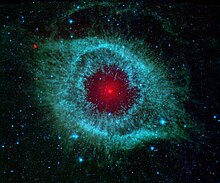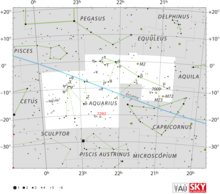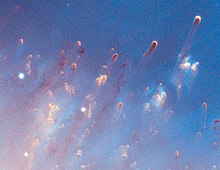Hi my good friends, how are you? Hope you are very fine! I miss everyone from Astrobin!
Data acquired from AFIL-1 and AFIL-2 by Alpha Zhang ! :-)Hope you enjoy this processing attempt of this nice piece of the sky called Helix Nebula :-) The image data is available via subscription on Starbase at
https://starbase.insightobservatory.comPlease visit also
https://www.interstellarprint.com/ :-)
As described, this picture was imaged by Alpha Zhang from a combo of these two scopes listed below:

 From Wikipedia:
From Wikipedia:The
Helix Nebula (also known as
NGC 7293 or
Caldwell 63) is a
planetary nebula (PN) located in the
constellationAquarius. Discovered by
Karl Ludwig Harding, most likely before 1824, this object is one of the closest of all the bright
planetary nebulae to
Earth.
[3] The distance, measured by the
Gaia mission, is 655±13 light-years.
[4] It is similar in appearance to the
Cat's Eye Nebula and the
Ring Nebula, whose size, age, and physical characteristics are similar to the
Dumbbell Nebula, varying only in its relative proximity and the appearance from the equatorial viewing angle.
[5] The Helix Nebula has sometimes been referred to as the "Eye of God" in
pop culture,
[6] as well as the "
Eye of Sauron".
[7][8]General informationThe Helix Nebula is an example of a
planetary nebula, formed by an intermediate to low-mass star, which sheds its outer layers near the end of its evolution. Gases from the star in the surrounding space appear, from our
vantage point, as if we are looking down a
helix structure. The remnant central stellar core, known as the central star (CS) of the planetary nebula, is destined to become a
white dwarf star. The observed glow of the central star is so energetic that it causes the previously expelled gases to brightly
fluoresce.The nebula is in the constellation of
Aquarius, and lies about 650
light-years away, spanning about 0.8
parsecs (2.5 light-years). Its age is estimated to be 10600+2300−1200 years, based on the ratio of its size to its measured expansion rate of 31 km·s−1.
[5]Structure
Structure and cometary knots are prominent in this Infrared false-color image taken by the
Spitzer Space Telescope[10]
The location of NGC 7293 (labelled in red)
The Helix Nebula is thought to be shaped like a
prolate spheroid with strong density concentrations toward the filled disk along the
equatorial plane, whose
major axis is inclined about 21° to 37° from our vantage point. The size of the inner disk is 8×19 arcmin in diameter (0.52 pc); the outer torus is 12×22 arcmin in diameter (0.77 pc); and the outer-most ring is about 25 arcmin in diameter (1.76 pc). The outer-most ring appears flattened on one side due to it colliding with the ambient
interstellar medium.
[11]Expansion of the whole planetary nebula structure is estimated to have occurred in the last 6,560 years, and 12,100 years for the inner disk.
[2] Spectroscopically, the outer ring's expansion rate is 40 km/s, and about 32 km/s for the inner disk.
Knots
A closer view of knots in the nebula
The Helix Nebula was the first planetary nebula discovered to contain
cometary knots.
[12] Its main ring contains knots of nebulosity, which have now been detected in several nearby planetary nebulae, especially those with a molecular envelope like the
Ring nebula and the
Dumbbell Nebula.
[13] These knots are radially symmetric (from the CS) and are described as "cometary", each centered on a core of neutral molecular gas and containing bright local
photoionization fronts or cusps towards the central star and tails away from it.
[14] All tails extend away from the Planetary Nebula Nucleus (PNN) in a radial direction. Excluding the tails, each knot is approximately the size of the
Solar System, while each of the cusp knots are optically thick due to
Lyc photons from the CS.
[2][5][15] There are about 40,000 cometary knots in the Helix Nebula.
[16]The knots are probably the result of
Rayleigh-Taylor instability. The low density, high expansion velocity ionized inner nebula is accelerating the denser, slowly expanding, largely neutral material which had been shed earlier when the star was on the
Asymptotic Giant Branch.
[17]The
excitation temperature varies across the Helix nebula.
[18] The rotational-vibrational temperature ranges from 1800
K in a cometary knot located in the inner region of the nebula are about 2.5'(arcmin) from the CS, and is calculated at about 900 K in the outer region at the distance of 5.6'.
[18]
Thanks for all the friendship Astrobin! :-)










Comments